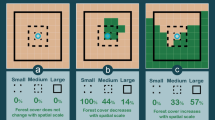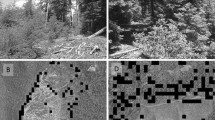Abstract
Predicting future space use by animals requires models that consider both habitat availability and individual differences in habitat selection. The functional response in habitat selection posits animals adjust their habitat selection to availability, but population-level responses to availability may differ from individual responses. Generalized functional response (GFR) models account for functional responses by including fixed effect interactions between habitat availability and selection. Population-level resource selection functions instead account for individual selection responses to availability with random effects. We compared predictive performance of both approaches using a functional response in elk (Cervus canadensis) selection for mixed forest in response to road proximity, and avoidance of roads in response to mixed forest availability. We also investigated how performance changed when individuals responded differently to availability from the rest of the population. Individual variation in road avoidance decreased performance of both models (random effects: β = 0.69, 95% CI 0.47, 0.91; GFR: β = 0.38, 95% CI 0.05, 0.71). Changes in individual road and forest availability affected performance of neither model, suggesting individual responses to availability different from the functional response mediated performance. We also found that overall, both models performed similarly for predicting mixed forest selection (F1, 58 = 0.14, p = 0.71) and road avoidance (F1, 58 = 0.28, p = 0.60). GFR estimates were slightly better, but its larger number of covariates produced greater variance than the random effects model. Given this bias-variance trade-off, we conclude that neither model performs better for future space use predictions.







Similar content being viewed by others
Data availability
Data are the property of Parks Canada. We do not have permission to share them.
Code availability
The code is available on GitHub (https://github.com/ljnewediuk/Ind_diff_FR.git).
References
Avgar T, Lele SR, Keim JL, Boyce MS (2017) Relative selection strength: quantifying effect size in habitat- and step-selection inference. Ecol Evol 7:5322–5330. https://doi.org/10.1002/ece3.3122
Bjørneraas K, Van Moorter B, Rolandsen CM, Herfindal I (2010) Screening Global Positioning System location data for errors using animal movement characteristics. J Wildl Manage 74:1361–1366. https://doi.org/10.2193/2009-405
Brehm AM, Mortelliti A (2021) Land-use change alters associations between personality and microhabitat selection. Ecol Appl. https://doi.org/10.1002/eap.2443
Brook RK (2010) Habitat selection by parturient elk (Cervus elaphus) in agricultural and forested landscapes. Can J Zool 88:968–976. https://doi.org/10.1139/Z10-061
Carlson BS, Rotics S, Nathan R et al (2021) Individual environmental niches in mobile organisms. Nat Commun 12:1–10. https://doi.org/10.1038/s41467-021-24826-x
Clark TJ, Matthiopoulos J, Bonnet-Lebrun AS et al (2019) Integrating habitat and partial survey data to estimate the regional population of a globally declining seabird species, the sooty shearwater. Glob Ecol Conserv 17:1–15. https://doi.org/10.1016/j.gecco.2019.e00554
Dingemanse NJ, Kazem AJN, Réale D, Wright J (2010) Behavioural reaction norms: animal personality meets individual plasticity. Trends Ecol Evol 25:81–89. https://doi.org/10.1016/j.tree.2009.07.013
Dugal CJ, Van Beest FM, Vander WE, Brook RK (2013) Targeting hunter distribution based on host resource selection and kill sites to manage disease risk. Ecol Evol 3:4265–4277. https://doi.org/10.1002/ece3.788
Dupke C, Bonenfant C, Reineking B et al (2017) Habitat selection by a large herbivore at multiple spatial and temporal scales is primarily governed by food resources. Ecography (cop) 40:1014–1027. https://doi.org/10.1111/ecog.02152
Edelaar P, Bolnick DI (2019) Appreciating the multiple processes increasing individual or population fitness. Trends Ecol Evol. https://doi.org/10.1016/j.tree.2019.02.001
Eggeman SL, Hebblewhite M, Bohm H et al (2016) Behavioural flexibility in migratory behaviour in a long-lived large herbivore. J Anim Ecol 85:785–797. https://doi.org/10.1111/1365-2656.12495
Fithian W, Hastie T (2013) Finite-sample equivalence in statistical models for presence-only data. Ann Appl Stat 7:1917–1939. https://doi.org/10.1214/13-AOAS667
Gaillard JM, Hebblewhite M, Loison A et al (2010) Habitat-performance relationships: finding the right metric at a given spatial scale. Philos Trans R Soc B Biol Sci 365:2255–2265. https://doi.org/10.1098/rstb.2010.0085
Gillies CS, Hebblewhite M, Nielsen SE et al (2006) Application of random effects to the study of resource selection by animals. J Anim Ecol 75:887–898. https://doi.org/10.1111/j.1365-2656.2006.01106.x
Hebblewhite M, Merrill EH (2009) Trade-offs between wolf predation risk and forage at multiple spatial scales in a partially migratory ungulate. Ecology 90:3445–3454
Hein CL, Öhlund G, Englund G (2013) Fish introductions reveal the temperature dependence of species interactions. Proc R Soc B Biol Sci. https://doi.org/10.1098/rspb.2013.2641
Holbrook JD, Squires JR, Olson LE et al (2017) Understanding and predicting habitat for wildlife conservation: the case of Canada lynx at the range periphery. Ecosphere. https://doi.org/10.1002/ecs2.1939
Johnson DH (1980) The comparison of usage and availability measurements for evaluating resource preference. Ecology 61:65–71. https://doi.org/10.2307/1937156
Johnston ASA, Boyd RJ, Watson JW et al (2019) Predicting population responses to environmental change from individual-level mechanisms: towards a standardized mechanistic approach. Proc R Soc B Biol Sci. https://doi.org/10.1098/rspb.2019.1916
Lesmerises R, St-Laurent MH (2017) Not accounting for interindividual variability can mask habitat selection patterns: a case study on black bears. Oecologia 185:415–425. https://doi.org/10.1007/s00442-017-3939-8
Manly BFJ, Mcdonald LL, Thomas DL et al (2002) Resource selection by animals: statistical design and analysis for field studies, 2nd edn. Kluwer Academic Publishers
Matthiopoulos J, Hebblewhite M, Aarts G, Fieberg J (2011) Generalized functional responses for species distributions. Ecology 92:583–589. https://doi.org/10.1890/10-0751.1
Matthiopoulos J, Fieberg J, Aarts G (2020) Species-Habitat associations. University of Minnesota Libraries Publishing, Saint Paul
McCabe JD, Clare JD, Miller TA et al (2021) Resource selection functions based on hierarchical generalized additive models provide new insights into individual animal variation and species distributions. Ecography (cop). https://doi.org/10.1111/ecog.06058
Merrick MJ, Koprowski JL (2017) Should we consider individual behavior differences in applied wildlife conservation studies? Biol Conserv 209:34–44. https://doi.org/10.1016/j.biocon.2017.01.021
Montgomery RA, Redilla KM, Ortiz-Calo W et al (2018) Evaluating the individuality of animal-habitat relationships. Ecol Evol. https://doi.org/10.1002/ECE3.4554
Morato RG, Connette GM, Ramalho EE et al (2018) Resource selection in an apex predator and variation in response to local landscape characteristics. Biol Conserv 228:233–240. https://doi.org/10.1016/j.biocon.2018.10.022
Muff S, Signer J, Fieberg J (2020) Accounting for individual-specific variation in habitat-selection studies: efficient estimation of mixed-effects models using Bayesian or frequentist computation. J Anim Ecol 89:80–92. https://doi.org/10.1111/1365-2656.13087
Muhly TB, Johnson CA, Hebblewhite M et al (2019) Functional response of wolves to human development across boreal North America. Ecol Evol 9:10801–10815. https://doi.org/10.1002/ece3.5600
Mumma MA, Gillingham MP, Johnson CJ, Parker KL (2019) Functional responses to anthropogenic linear features in a complex predator-multi-prey system. Landsc Ecol 34:2575–2597. https://doi.org/10.1007/s10980-019-00905-9
Mysterud A, Ims RA (1998) Functional responses in habitat use: availability influences relative use in trade-off situations. Ecology 79:1435–1441
Northrup JM, Hooten MB, Anderson CRJ, Wittemyer G (2013) Practical guidance on characterizing availability in resource selection functions under a use–availability design. Ecol Soc Am 94:1456–1463
Ofstad EG, Markussen SS, Saether B-E et al (2020) Opposing fitness consequences of habitat use in a harvested moose population. J Anim Ecol. https://doi.org/10.1111/1365-2656.13221
Palmer MS, Fieberg J, Swanson A et al (2017) A ‘dynamic’ landscape of fear: prey responses to spatiotemporal variations in predation risk across the lunar cycle. Ecol Lett 20:1364–1373. https://doi.org/10.1111/ele.12832
Perrig PL, Lambertucci SA, Cruz J et al (2020) Identifying conservation priority areas for the Andean condor in southern South America. Biol Conserv 243:108494. https://doi.org/10.1016/j.biocon.2020.108494
Prokopenko CM, Boyce MS, Avgar T (2017a) Extent-dependent habitat selection in a migratory large herbivore: road avoidance across scales. Landsc Ecol 32:313–325. https://doi.org/10.1007/s10980-016-0451-1
Prokopenko CM, Boyce MS, Avgar T (2017b) Characterizing wildlife behavioural responses to roads using integrated step selection analysis. J Appl Ecol 54:470–479. https://doi.org/10.1111/1365-2664.12768
Schirmer A, Herde A, Eccard JA, Dammhahn M (2019) Individuals in space: personality-dependent space use, movement and microhabitat use facilitate individual spatial niche specialization. Oecologia 189:647–660. https://doi.org/10.1007/s00442-019-04365-5
Stjernman M, Sahlin U, Olsson O, Smith HG (2019) Estimating effects of arable land use intensity on farmland birds using joint species modeling. Ecol Appl 29:1–18. https://doi.org/10.1002/eap.1875
Trevail AM, Green JA, Bolton M et al (2021) Environmental heterogeneity promotes individual specialisation in habitat selection in a widely distributed seabird. J Anim Ecol. https://doi.org/10.1111/1365-2656.13588
van Beest FM, Mcloughlin PD, Mysterud A, Brook RK (2016) Functional responses in habitat selection are density dependent in a large herbivore. Ecography (cop) 39:515–523. https://doi.org/10.1111/ecog.01339
Wilber MQ, Chinn SM, Beasley JC et al (2020) Predicting functional responses in agro-ecosystems from animal movement data to improve management of invasive pests. Ecol Appl 30:1–14. https://doi.org/10.1002/eap.2015
Wittemyer G, Northrup JM, Bastille-Rousseau G (2019) Behavioural valuation of landscapes using movement data. Philos Trans R Soc B Biol Sci 374:20180046. https://doi.org/10.1098/rstb.2018.0046
Acknowledgements
Elk captures were conducted by Riding Mountain National Park with support from Manitoba Agriculture and Resource Development, and aerial surveys were conducted by Riding Mountain National Park staff in conjunction with local First Nations communities. All in-kind GPS data were provided by Parks Canada, in part collected and managed by R. Brook (2003-2005). We would like to thank members of the Wildlife Evolutionary Ecology Lab at Memorial University for support with coding and feedback on the manuscript. G. Street and J. Northrup provided helpful comments on an earlier version of this manuscript in addition to several anonymous reviewers. All work research was conducted in compliance with Canadian law.
Funding
This work was supported by a funding agreement from the Manitoba Fish and Wildlife Enhancement Fund (#5951) awarded to EVW and LN and a Mitacs Accelerate Fellowship (with partner organization Nature Conservancy of Canada) awarded to LN, and a NSERC Discovery Grant awarded to EVW. CMP was supported by a Vanier Canada Graduate Scholarship and LN was supported by a NSERC PGS-D.
Author information
Authors and Affiliations
Contributions
LN, CMP, and EVW conceived of the study. LN performed the analysis and led the writing of the manuscript. All authors provided comments on earlier drafts of the manuscript. All authors have read and approve of the manuscript.
Corresponding author
Ethics declarations
Conflict of interest
The author declares that they have no conflict of interest.
Ethics approval
Data were made available by Riding Mountain National Park and collected in accordance with approved animal care protocols from the University of Saskatchewan (#20060067), University of Manitoba (#F01-037), and Memorial University of Newfoundland (#16-02-EV).
Additional information
Communicated by Dan MacNulty.
Electronic supplementary material
Below is the link to the electronic supplementary material.
Box 1 The link between individual differences and the functional response
Box 1 The link between individual differences and the functional response
The functional response in habitat selection posits that animals adjust their habitat selection as availability changes (Mysterud and Ims 1998). However, agreement between the population-level functional response and individual habitat selection depends on how much individual variation affects the ability of the functional response to predict the selection of individuals when availability changes.
In Fig. 7, each coloured line represents a single individual. Individuals exhibit a behavioural reaction norm for a habitat, the direction and magnitude of which varies along an environmental gradient as an individual’s home range changes between two time periods. The functional response for the habitat is positive, i.e., the slope of the increase in selection for the habitat increases along the environmental gradient. Such a response could occur if the environmental gradient measures risk of predation, and the habitat provides cover from that risk. When all individuals respond similarly to the environmental gradient as their positions vary along the environmental gradient, their individual behavioural reaction norms (BRNs) are correlated with the functional response pattern (panel a). In such cases, the functional response is a good predictor of individual selection.
However, if some individuals exhibit a response to the environmental gradient that differs from the majority of the population, the functional response is less reliable for predicting individual selection (panel b). Deviation from the functional response could occur if individuals exhibit consistent differences in their habitat selection regardless of the environmental gradient. In such cases, the mean selection by all individuals in the population (dashed line) is likely to be a better predictor than the functional response because it minimizes the variation between all individuals and their predicted selection.
Rights and permissions
About this article
Cite this article
Newediuk, L., Prokopenko, C.M. & Vander Wal, E. Individual differences in habitat selection mediate landscape level predictions of a functional response. Oecologia 198, 99–110 (2022). https://doi.org/10.1007/s00442-021-05098-0
Received:
Accepted:
Published:
Issue Date:
DOI: https://doi.org/10.1007/s00442-021-05098-0




